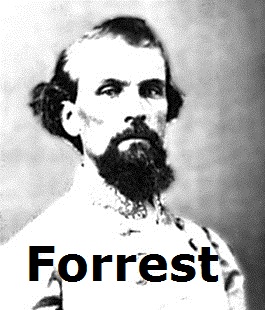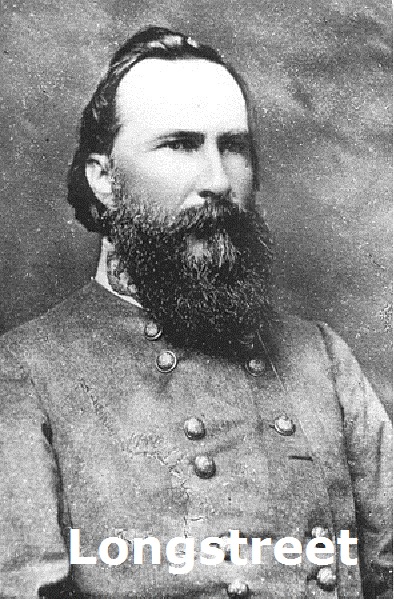Civil War: Catoosa's Bloodiest Days
The Battle of Chickamauga
By Randall Franks
On the fertile fields of Catoosa and Walker counties on Sept. 19-20, 1863, two forces whose iron wills are etched in stone and bronze across 5,200 acres of ground, clashed in combat on the Chickamauga Battlefield.
The Federal leaders planned to support the troops with the bounty from the land and farms, but local support for Confederate forces and hospitals already left most cupboards bare.
A wave of war rolled across the South, leaving in its wake shattered lives, ruins of ash and embers where once productive farms, businesses and plantations stood.
Federal soldiers raided and looted farms and homes for anything edible.
Several families shared lore about looting in the book “Catoosa County, Georgia Heritage.”
Some claim that showing Masonic aprons was the only way some area residents, such as Thomas A. Williams of Woodstation, managed to spare belongings meant for Sherman’s torches.
On the Hunt farm at Chickamauga Battlefield, Betts Berry of Chickamauga shares a story about how Clarissa Hunt tried to stop a soldier from heading upstairs in the Hunt house during one such raid. The soldier started to shoot her, but his commanding officer stopped him. After being marched to Crawfish Springs and detained, Clarissa returned to find two dead Union soldiers at her house. She, her mother and a slave buried them, fearing the Federal troops would think she had killed them.
According to Jerry Fox of Charlotte, N.C., after the Union troops took all but the last hog from the farm of Minerva Taylor Fox, it escaped from underneath the house, and troops confiscated it. The 19-year-old Minerva went with two brothers to the camp and demanded to see the officer in charge. Complaining about how his troops had ruined the garden, stole the chickens and the badly needed hog, Minerva won over the commander, and he had his men dress and return the hog.
In Dogwood Valley at the home of John Caldwell, Susie Blaylock McDaniel describes in the “Official History of Catoosa County” how Caldwell’s daughter stood behind the front door as Federal troops marched by on one of their raids. Inside the front door on June 16, 1864, she wrote on the wall: “The Federals have taken all our corn, fodder, chickens and hogs and again are passing through.”
A Chance Meeting
As the Battle of Chickamauga loomed, Federal and Confederate forces were unsure of each other’s location, and the eventual meeting of forces at West Chickamauga Creek came out of two units meeting each other by chance.
Despite better-laid plans by generals, this happenstance meeting decided the place where the battle began.
These initial shots heralded two of the bloodiest days of warfare in history.
In “Reminiscences of the Civil War,” Confederate Maj. Gen. John B. Gordon compared the battle’s three-to-one losses to history’s greatest battles at Waterloo, Wagram, Valmy, Magenta, Soferino, Zurich and Lodi. The battlefield is where an estimated 35,000 of the roughly 120,000 Federal and Confederate troops were killed, wounded or listed as missing.
“Words, however, cannot convey an adequate picture of such scenes; of the countless costly, daring assaults; of the disciplined or undisciplined but always dauntless courage; of the grim, deadly grapple in hand-to-hand collisions; of the almost unparalleled slaughter and agony,” he wrote.

“As (Gen. Braxton) Bragg prepared to assail the Union left, (Gen. George H.) Thomas, feeling his way through the woods to ascertain what was in his front, unexpectedly struck the Southern right, held by (Gen. Nathan Bedford) Forrest’s cavalry, and thus inaugurated the battle,” Gordon wrote. “Forrest was forced back; but he quickly dismounted his men, sent the horses to the rear, and on foot stubbornly resisted the advance of the Union infantry. Quickly the Confederates moved to Forrest’s support. The roar of small arms on this extreme flank in the early morning admonished both commanders to hurry thither their forces. Bragg was forced to check his proposed assault upon another portion of the Union lines and move to the defense of the Confederate right. Rapidly the forces of the two sides were thrown into this unexpected collision, and rapidly swelled the surging current of battle.”

Confederate Lt. Gen. James Longstreet and two of his divisions reinforced Bragg at Chickamauga, arriving by rail at Catoosa Station in the largest troop movement by rail at that time. The presence of Longstreet’s forces helped to turn the tide of the battle.
Before the Battle of Chickamauga, the ground upon which the armies fought had been endless acres of farms and forests. The center of each farm was the home of a Catoosa or Walker family. These family names, such as Hunt, Kelley, Reed, McAbee, McDonald, Park, Poe and Brotherton, among others, are now permanently entwined, and in a way enshrined, in the history of the United States and Catoosa County.
From Their Cabin Doors
While most of the families gallantly sent male members of their kin to defend the South, it is certain they never imagined that from their cabin doors they would look across their fields strewn with dead and decaying bodies.
As the battle began, the Reed family history claims that the first cannon fired sat in their yard near Reeds Bridge.
Jacob and Sallie Reed had five boys who volunteered for service: Jimmy, Tommy, Charlie, Bunk and D.O.
Four of them took part in the battle, as did house guest John Ingram. Ingram is the only known soldier buried today in the park outside family cemeteries, and was found by the Reed brothers, who buried him and marked his grave.
As the battle waged on all sides, the Reed house became a hospital, and Sallie Reed tended the wounded on the floor of her home.
Among the wounded was Gen. Ben Hardin Helm, brother-in-law to Pres. Abraham Lincoln; Major Rice E. Graves, a young boy from the 9th Kentucky; and soldier Fred Joyce.
Joyce wrote about his time at the Reed house in 1884 for the book “The Southern Bivouac”:
“The passage and the hall were full of groaning and dying soldiers. Mrs. Reed was passing to and fro, rendering all the assistance in her power, and much distressed over our pitiable condition.
“The young soldier who shared my mattress was in great pain, and when this dear, good woman would come to our bed, he would take her hand and hold it and caress it and call her mother, telling her that she reminded him so much of his own dear mother, in Kentucky…. She told us she had two boys in the same battle, from whom she had not heard. I heard her repeatedly say, ‘I am doing for you, my son, what I hope some other mother is doing for my boys, if they need it; if God wills they are yet alive.’”
Sallie Reed’s boys came home safe from that battle, but her son Charlie was later killed at the Battle of Franklin, Tenn.
Confederate soldier William C. McDonald was the son of John and Bell McDonald, who lived in a two-room log house near the crossing of Lafayette and Reeds Bridge Roads. According to the book “Joel Kelly” by Paul and Alba Smith, he joined the service on the same day as his friend and neighbor, George Washington Kelley.
Kelley lived with his parents, Elisha and Sarah, who rented a farm from his Uncle Elijah.
Both men fought at Fort Donelson, Tenn., with Kelley receiving a wound to his arm. McDonald was captured, exchanged and returned to fighting. McDonald then served as a teamster at Chickamauga hauling wounded soldiers to area hospitals.
Kelley left his unit to return home as the fighting drew near, but he surrendered to Union forces before the battle began.
The Kelley farmhouse was destroyed during the battle.
In the “History of Walker County, Georgia,” McDonald recalls the Federal army taking his father to serve as a guide for Gen. William S. Rosecrans.
His father told the story of being with Rosecrans when the Union right was broken.
Rosecrans tried to rally his troops, but failed, and told his companions, including John McDonald, “If you care to live any longer, get away from here.”
The Federal troops took the elder McDonald to Chattanooga and held him until after the Battle of Missionary Ridge concluded.
Left: Confederate soldier George Washington Kelley, holding Rufus Clayton Kelley; Amanda L. McDonald Kelley (wife) with Dora D. Kelley (Hancock) at her knee. Gertie May Kelley (Fuller) at Washington’s knee. Around their parents, from left: Alice E. Kelley (Howard), L. Belle Kelley (Fuller), Lee Anderson Kelley, Hettie Elizabeth Kelley, Anna Laura Kelley (Brown), Clemmie C. Kelley (Henderson), Clark Alexander Kelley, and Mary V. Kelley (Howard).
Farmer Poe's Story
Catoosa farmer Larkin Poe was serving in Company K, 4th Georgia Cavalry, in Rome, Ga., when the battle began. Poe’s unit moved forward, but the company did not arrive until after the battle was over.
He borrowed a horse and rode to his home in search of his wife, Sarah, and his two children. In the 1920s, Poe related his memories about the search in the book “History of Walker County, Georgia”:
“The moon was far down the west and cast a ghostly light over the woods and fields. The stillness of the night was unbroken except for the sound of my horse’s hooves and the hoot of some solitary owl. I had seen an old house near Jay’s mill filled with wounded and suffering men, and I had hardly started till I began to see dead soldiers yet unburied, lying in and near the road. I rode on, turning my horse first to the right and then to the left to avoid the thick-strewn bodies. In places I saw where great trees had been splintered by shells and riddled by bullets… Just before reaching the Brotherton house I came upon a scene of death and destruction noteworthy even on that terrible field. I saw a piece of artillery, evidently a Federal piece, which had been knocked from the wheels by a direct hit from our guns, and apparently most all of the horses and men belonging to the gun had perished there for their bodies lay in grotesque heaps around their piece.”
Poe rode closer to the Brotherton house, where his wife’s family lived. Wounded soldiers filled the house, but the nurses could give him no word of his family. He found his father-in-law inside, and the pair traveled to his farm and discovered it in ashes, bodies all over his fields, and his family gone.
Poe finally discovered that his family had taken refuge with other survivors in a ravine near the Snodgrass house. He found them, along with roughly 60 others, gathered around a log fire.
This group of women, children and elderly had waited in the ravine without shelter, food or water for eight days.
Poe and his family never returned to the farm.
While generals later debated who won the Battle of Chickamauga, history marks it a Confederate victory. In retrospect, the people of Catoosa County did not have much to celebrate. Most returned to their destroyed homes, their belongings gone and fields in ruins, covered with the bodies of those who struggled in mortal combat.
If a structure did survive, it was a hospital; so most families had to abandon them indefinitely. For some families, the dead lay in their fields for months, while others simply never returned.
Looming ahead in Catoosa County’s not-too-distant future was the Battle of Ringgold Gap, various skirmishes and Federal occupation.